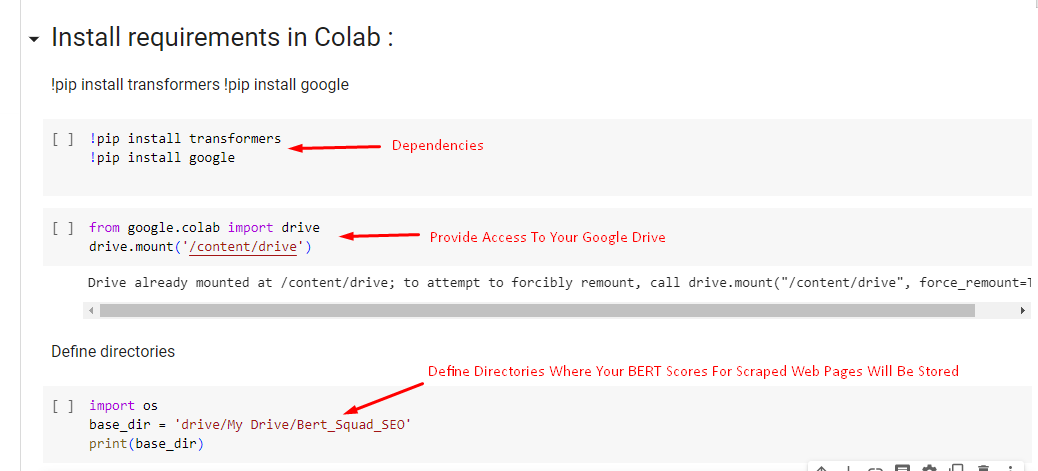
- The Query = How SEO Content Writers Can optimize BERT Scores?
- Top Ranked Page = https://www.webfx.com/blog/internet/google-bert/
- BERT Score of the top page = 0.9767347251 (98%)
As you can see, all the top ranking pages in this sheet have a BERT score that’s above the 80th percentile for the query
Note: the BERT score of a page shows the mathematically derived match between the context and intent of the page in relation to the search query
I believe that BERT score optimization, combined with Higher Entity Salience Scores, can help SEO content writers to achieve first page ranking for their articles
Python Script For Calculating Google BERT Scores
Here is a python script you can use to scrape the web and compare how competitor sites score against yours for various queries.
Here are the steps for running the script
(1) Install the Dependencies in Google Colab

(2) Choose Your Query or Keyword against which the top Websites will be scored

(3) Scrape Google to extract web pages, their ranking position, and the search date

The above is a clear guide on how to calculate BERT scores by yourself. But what are BERT scores, what’s their significance and if you know how an article measures against this metric, how can you improve the scores
Introduction
As search engines become more sophisticated in understanding natural language, traditional metrics for evaluating content are evolving. One such metric that has gained prominence is the BERT Score.
BERT (Bidirectional Encoder Representations from Transformers) Score measures the relevance and quality of content based on contextual understanding.
In this blog post, we will provide a step-by-step guide on how to calculate BERT Scores and leverage this metric to improve your content’s performance.
Understanding BERT Score
BERT Score evaluates how well your content matches the context and intent of search queries. Unlike traditional metrics that focus on keyword density or backlinks, BERT Score emphasizes natural language processing and semantic relevance. It takes into account the fine-grained nuances of user queries, enabling search engines to provide more accurate and relevant search results.
Here’s how BERT takes a look at the context of the sentence or search query as a whole:
- BERT takes a query
- Breaks it down word-by-word
- Looks at all the possible relationships between the words
- Builds a bidirectional map outlining the relationship between words in both directions
- Analyzes the contextual meanings behind the words when they are paired with each other.
How Google Utilizes BERT scores
(a) Enhancing Search Relevance: One of the primary ways Google utilizes BERT Scores is by improving search relevance. BERT allows Google to better comprehend the nuances and context of search queries, enabling it to deliver more accurate search results. By considering the BERT Score, Google can identify content that aligns closely with the user’s intent, resulting in a more satisfying search experience.
(b) Understanding User Intent: BERT Scores help Google understand user intent more effectively. With the ability to interpret complex search queries, Google can decipher the true meaning behind the words used by users. This allows the search engine to provide more precise answers and relevant content, even when the user’s query is not phrased explicitly.
(c) Contextual Understanding: BERT Scores take into account the context in which words are used. Google’s algorithm analyzes the surrounding words and phrases to grasp the meaning and context of the query. This contextual understanding enables Google to present search results that match the user’s intent, even when keywords alone may not capture the full meaning.
(d) Semantic Relevance: Semantic relevance is another crucial aspect that BERT Scores consider. Instead of relying solely on individual keywords, BERT focuses on the overall meaning and semantics of the content. By understanding the relationships between words, BERT helps Google identify content that provides the most accurate and valuable information to users.
(e) Natural Language Processing: BERT Scores leverage the power of natural language processing (NLP) to enhance search results. With NLP, Google can interpret and process human language more effectively, taking into account factors such as sentence structure, grammar, and context. This enables Google to deliver search results that better match the natural language used by users.
Impact of BERT Scores on Search Rankings
BERT Scores play a significant role in determining search rankings. Websites that optimize their content to align with BERT’s contextual understanding and semantic relevance have a higher chance of ranking well in search results. By creating content that aligns with the user’s intent and addresses their queries comprehensively, website owners can improve their BERT Scores and increase their visibility on search engine results pages.
How To Optimize BERT Scores
(1) Optimize for Featured Snippets: Featured snippets are highly visible and can significantly boost organic traffic. Content writers should aim to provide concise and direct answers to commonly asked questions related to their target keywords. Structuring content in a way that makes it easy for search engines to extract relevant information increases the chances of obtaining a featured snippet.

Featured Snippet Rules For Content Teams
- Rule 1: Use a “What is [Keyword]”Heading
- Rule 2: The First sentence under the heading should use an Ïs” statement
- Rule 3: Always start the first sentence with the core keyword
- Rule 4; The 1st sentence should provide a definition and the second should explain the most important information about the keyword
- Rule 5: Never Use Brand names in portions of text that will be pulled into a featured snippet e.g. Listicles, Tables etc
- Rule 6: Eliminate all first person language in the featured snippet text
- Rule 7: Be as concise as possible
- Rule 8: Refine. If we don’t capture it, then observe the existing snippet and product a content structure that is of superior concise and explicative quality
(2) Enhance Your Content Structure: Organizing your content with clear headings and subheadings helps search engines understand the structure and hierarchy of information. Proper use of H1, H2, and H3 tags signals the importance of specific sections. Aim for a logical flow and readability, incorporating keywords naturally throughout the content.
(3) Focus On Contextual Relevance: Understanding the user’s intent behind search queries is crucial for creating relevant content. Tailor your content to match user expectations, addressing specific pain points and providing valuable solutions. Analyzing search engine result pages (SERPs) can provide insights into the context surrounding the topic.
(4) Optimal Content Length: Long-form content tends to perform better in terms of BERT Score. Aim for comprehensive and in-depth content that covers the topic thoroughly. Strive to strike a balance between quality and quantity, ensuring that each word adds value. Don’t hesitate to update and refresh existing content to maintain relevance.
(5) Prioritize Language and Style: Simplicity and clarity should be the guiding principles of your content. Use plain language and avoid excessive jargon that might confuse readers and search engines alike. Craft clear and concise sentences in active voice, incorporating LSI (Latent Semantic Indexing) keywords to demonstrate a deeper understanding of the topic.

(6) Readability and User Experience: Enhancing the readability and user experience of your content is vital for optimizing BERT Score. Break up the text with bullet points, lists, and subheadings for easy scanning. Keep paragraphs concise and consider incorporating multimedia elements like images and videos where relevant. Ensure your content is mobile-friendly and responsive.
(7) User Engagement Signals: User engagement signals, such as dwell time and click-through rates (CTR), are closely related to BERT Score. Encourage user interaction by enabling comments and social sharing. Craft engaging headlines and meta descriptions that entice users to click through. Engage your audience with high-quality content that encourages them to spend more time on your page.
(9) Monitoring and Optimization: Regularly monitor your content’s BERT Score using SEO tools to track its performance. Continuously review and update your content to keep it fresh and relevant. Pay attention to user feedback and adjust your content accordingly. Stay informed about search engine algorithm changes that may impact your content’s visibility.
Conclusion
Calculating BERT Scores allows you to measure the relevance and quality of your content in alignment with user queries and intent. By leveraging the power of BERT models and following the steps outlined in this guide, you can gain valuable insights into how well your content matches user expectations. Remember to keep refining and optimizing your content based on the BERT Scores to enhance its visibility and drive organic traffic to your website.
In the ever-evolving landscape of SEO and content optimization, understanding and utilizing metrics like BERT Score is crucial to staying ahead of the competition and delivering valuable content to your audience.

